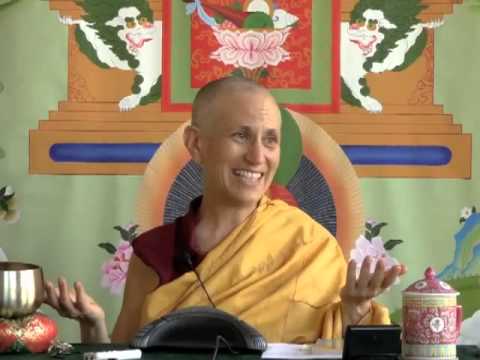Five absorptions factors in brief
Stages of the Path #129: The Fourth Noble Truth
Part of a series of Bodhisattva’s Breakfast Corner talks on the Stages of the Path (or Lamrim) as described in the Guru Puja text by Panchen Lama I Lobsang Chokyi Gyaltsen.
- A brief description of each of the five absorption factors
- The qualities of the absorption factors
- Differentiating the pleasure felt from meditation from worldly pleasure
We’re going to start on the five absorption factors that we want to cultivate, and that when they are perfected will lead us to have the first jhana and very deep concentration.
The first of these is called “coarse engagement,” or vitakka. If you’ve studied mind and mental factors there are four unchangeable ones. This is one of them. Here, in this particular case, what it is is a coarse kind of involvement with your meditation object. It’s the part of the mind that uplifts the mind and puts it on the object.
The second one is vicara, or refined engagement. This is also one of the changeable mental factors. Whereas the coarse engagement lifts up the mind and puts it on the object, the refined engagement keeps it there over a period of time. They often make the analogy that coarse engagement is like ringing the bell, and then the refined engagement is the sound of the bell that comes afterwards. Something along that line.
Let’s say you’re doing meditation on the breath, then your coarse engagement would get you on the breath, and your refined engagement would be really steady on the breath and would be able to see all the details and what’s happening with each breath as it goes in and as it goes out.
Or if you’re meditating on the figure of the Buddha, the refined engagement would know all the details and get them in order, and so on.
I know somebody’s going to say, “Well what’s the difference between this and mindfulness?” I beat you too it. I knew you were going to ask that. I think all these mental factors work together. Sometimes when we talk about the mental factors we try and divide them into nice, neat categories so that they don’t overlap with each other. But that’s just our conceptual grasping mind that wants to divide up the pie so that there are no crumbs. But I think that when we’re really talking about how the mind works there are so many different mental factors that are involved in a certain cognition and they all kind of help each other, and they’re all there working together to do something. So I don’t think we can divide up the functions so clearly always.
Then the third one is called rapture, or the Sanskrit word is “píti.” This is a very delighted kind of mind. When your mind’s really focusing single-pointedly they say that your mind is very delighted, very uplifted, it feels very happy. This is one of those mental factors that make it like that.
This rapture has a certain quality…. It’s not totally smooth. It’s a little bit, like, “Wow, this is really neat.” So at a certain point you have to kind of get over that.
Then the next one is bliss, or sukha. This is a very pleasant feeling, very joyous feeling. It’s much more steady than rapture. Much more steady, very blissful, because the mind is so peaceful, not filled with all of our usual beserky thoughts and worries and anxieties, so a real sense of peace in the mind.
And then the last factor is called one-pointedness (ekaggata). This mental factor kind of unifies the mind, it brings all the other mental factors together on the object.
That’s just in brief. We’ll talk about them a little bit more as the days go on. But it gives you some idea of the kinds of things that we need to strengthen in our own meditation. If you feel blissful in your meditation it’s not bad, don’t get rid of it. Stay with it. Just don’t cling to it. When you have deep states of concentration the mind should feel very blissful. It’s something to cultivate, but it’s not the kind of bliss, or delight, or happiness that we get from sense objects. Because any kind of pleasure for sense objects, the mind usually has a lot of anxiety: “How am I ever going to get this again? It’s so good now, maybe I’m going to lose it. Then what am I going to do if I lose it and it goes away? What’s going to happen if somebody takes the object I’m attached to? Or maybe there’s something better.” So our usual sense pleasure happiness, it’s really quite agitated, it’s often, like I said, very filled with worry, fear, and anxiety about losing it. But this kind of delight and bliss and joy that comes from concentration is much smoother, the mind’s very quiet, so it just stays in this kind of delighted peaceful state. That’s good.
[In response to audience] When you’re meditating and you feel some happiness, or some joy, it’s definitely a different kind of happiness than your sense pleasure delight, isn’t it? So that means that you’re going in that direction. You’re increasing that mental factor.
The bliss (sukha), when they talk about Amitābha’s pure land, the land of great bliss, it’s “Sukhavatī.” It’s the same sukha.
Venerable Thubten Chodron
Venerable Chodron emphasizes the practical application of Buddha’s teachings in our daily lives and is especially skilled at explaining them in ways easily understood and practiced by Westerners. She is well known for her warm, humorous, and lucid teachings. She was ordained as a Buddhist nun in 1977 by Kyabje Ling Rinpoche in Dharamsala, India, and in 1986 she received bhikshuni (full) ordination in Taiwan. Read her full bio.


